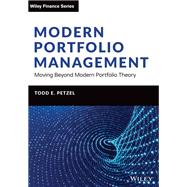Get a practical and thoroughly updated look at investment and portfolio management from an accomplished veteran of the discipline
In Modern Portfolio Management: Moving Beyond Modern Portfolio Theory, investment executive and advisor Dr. Todd E. Petzel delivers a grounded and insightful exploration of developments in finance since the advent of Modern Portfolio Theory. You’ll find the tools and concepts you need to evaluate new products and portfolios and identify practical issues in areas like operations, decision-making, and regulation.
In this book, you’ll also:
- Discover why Modern Portfolio Theory is at odds with developments in the field of Behavioral Finance
- Examine the never-ending argument between passive and active management and learn to set long-term goals and objectives
- Find investor perspectives on perennial issues like corporate governance, manager turnover, fraud risks, and ESG investing
Perfect for institutional and individual investors, investment committee members, and fiduciaries responsible for portfolio construction and oversight, Modern Portfolio Management is also a must-read for fund and portfolio managers who seek to better understand their investors.








